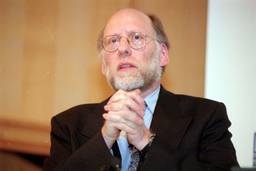The Digital Education Divide
Massive Open Online Courses threaten to aggravate the problems they were designed to solve.
Susan J. Douglas

The latest, hottest thing in higher education is the MOOC: Massive Open Online Course. Students — tens of thousands, supposedly — can now sit in their PJs in their bedrooms and take an online course, free and typically for no credit. If they finish, they get a certificate. The really hot MOOCs are taught by renowned experts whose lectures can now be seen by anyone with Internet access. As Stanford, Harvard, MIT and others have introduced MOOCs, there’s been something of a panic among universities to get in on the ground floor or else be left in the dust as some old, out-of-touch, brick-and-mortar has-been.
The hype: MOOCs will revolutionize higher education. “The single biggest change in education since the printing press” is how Anant Agarwal, the computer scientist who heads the MIT-Harvard consortium offering MOOCs, has described them. “There’s a tsunami coming,” says Stanford President John Hennessy. Thomas Friedman has hailed MOOCs as driving down the cost of college and possibly even replacing traditional higher education.
Time for a skeptical breather. Would it be educational to sit in — digitally — on a free course taught by a world-famous expert in, say, art history, astronomy or Internet law? You bet. But no one knows what the funding model for MOOCs is going to be. If they’re free, how are they supported over time? Lurking in the background, given the need for a workable financial structure, is the further commercialization of higher education into for-profit centers.
The excitement about MOOCs coincides with widespread defunding of public higher education. State after state has slashed its education budget, forcing tuition prices up and constricting the ability of many institutions to hire or retain faculty. Federal funding cuts to agencies like the National Science Foundation are hampering the country’s preeminence in research. And conservatives who hate science and the liberal arts have stereotyped college professors as pampered divas who work six hours a week, when most faculty I know work somewhere between 60-70 hours a week, sometimes much more.
Online courses represent yet another way that corporate-minded administrators can squeeze more work out of faculty for less pay. Teaching an online course is considerably more labor-intensive than teaching in the classroom: The Chronicle of Higher Education reports that professors typically spend over 100 hours preparing MOOCs, and then there are the 8-10 hours every week presiding over chats, responding to emails and updating material. Right now, faculty are not being compensated for this extra work.
Of course, the flipside is supposed to be lower costs for students. MOOCs are hyped as more cost-efficient, because they allow each professor to teach many more students. But we should be wary of the assumption that MOOCs can serve as a substitute for, rather than a supplement to, person-to-person teaching. At most universities, enormous efforts are made to ensure diversity among the students and faculty, so that people meet others not like them, learn from them, and hopefully develop a tolerance for, even an embrace of, difference. It’s not just that white kids and students of color (and of different nationalities) meet each other and even become friends. Straight kids meet LGBT kids. Rural kids meet city kids. And they do so face-to-face, in the classroom, as well as in their dorms, clubs and the like. They form networks and gain social capital that serves them throughout their lives.
True, many students who might want to access this experience can’t afford it, especially as tuition costs skyrocket. But any solution proffered by the very people raising the price tag of a university degree should be met with skepticism. Sitting the have-nots in front of a screen in their parents’ houses and giving them certificates will not democratize higher education. With a MOOC, you might get that Stanford course, but no Stanford credit for it, and no Stanford experience either. Thus MOOCs perpetuate the distinction between those who have the means to attend elite universities and get a degree, and those who do not. And we know which one of those students will get the better job.
So let’s be a bit wary of all the 2.0 utopian hype about MOOCs, because under the guise of equal access to knowledge lurk perils for students and faculty alike.
Susan J. Douglas is a professor of communications at the University of Michigan and a senior editor at In These Times. She is the author of In Our Prime: How Older Women Are Reinventing the Road Ahead.









